Rarest Gold Coins in the World
Introduction
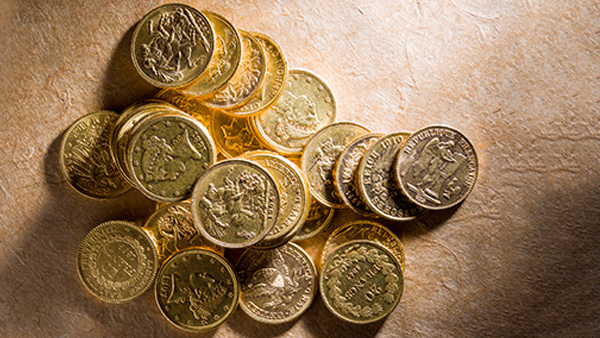
The world of rare coins is filled with treasures that captivate collectors and investors alike. In this article, we will delve into the definition of "the rarest gold coin", exploring its historical significance, unique features, and allure for numismatic enthusiasts. From its intricate design and limited mintage to its exceptional value and esteemed reputation, the rarest gold coin is a testament to the artistry, history, and worth that these precious metal creations represent.
Join us on this journey as we uncover the allure of the rarest gold coin in the world.
Value Of Rarest Gold Coins
The value of the rarest gold coins cannot be overstated. While not made of 100% pure gold (most boast .9999 or .99999 purity marks), these coins possess a blend of historical significance, extreme rarity, and overwhelming collectible demand, making them highly sought after by numismatists and investors alike.
What sets these coins apart is their gold content and their pristine mint state condition. That means that they have been preserved in an immaculate state, free from any wear or damage. Their rarity, gold content, and physical condition contribute to their impressive value.
These rare coins often command record prices at auctions and are highly cherished by collectors. Scarcity is a key factor in driving up their value. With only a limited number of these coins in existence, their desirability reaches unprecedented levels.
Additionally, the unique design elements and features of these coins add to their allure. From the intricate details of Lady Liberty to the breathtaking artistry of Augustus Saint-Gaudens, each piece tells a story of its own.
Collectors and investors understand the immense worth associated with these coins. Their value not only lies in their precious metal content but also in the historical and artistic significance they hold. It is through these rare coins that we can preserve and appreciate the rich history of our past.
TYPES OF GOLD COINS
When it comes to gold coins, several types stand out for their rarity, historical significance, and beauty. These coins capture the attention of collectors and investors alike, offering a glimpse into the past and serving as a valuable asset in the present.
From the elegant American Liberty gold coins to the iconic Saint-Gaudens double eagles, each coin bears details that add to its unique allure and charm. Whether you're a coin enthusiast or a history buff, exploring the different types of gold coins will not only enrich your knowledge but also open up a world of possibilities for your collection.
There are four main types of Gold Coins:
1. Bullion Coins
Bullion coins have a recognized weight and purity, and this is engraved on their surface (typically 22 to 24 carats). They are made of the same type of precious metals as bullion bars and carry value mainly based on their gold content. They are considered legal tender as their weight and purity is guaranteed by a sovereign state.
2. Proof Coins
Proof coins are higher quality coins than bullion and are made in relatively low quantities. The term “proof” refers to the coin’s finish. The proof blanks are specially treated, hand-polished, and cleaned to ensure quality strikes.
The coins are typically struck more than once, or with heavier pressure to accentuate the details. Because of the extra care taken in striking the coin, the field area may appear to be smoother. The coins are also encapsulated to maintain quality and are accompanied by a certificate of authenticity.
3. Numismatic Coins
Numismatic coins tend to be older coins that are valued both for their precious metal content and their collector’s value. In general, these are worth more because of their collectability, rarity, and age.
However, the authenticity of these coins often comes into question and so must be independently certified by third-party services. These coins usually have historical significance and are tied to important economic or political events.
4. Semi-Numismatic Coins
Semi-numismatic coins are valued both for their gold content and for their collectability. An example of this would be the commemorative coins issued by the British Royal Mint for the Queen’s Jubilee, or the American Liberty coins.
While these are generally advertised as “Mint State” or “Brilliant Uncirculated”, these labels are less indicative of their value in this case. Semi-numismatic coins are specifically produced brand new as a collector’s item, so the value is more dependent on how much demand there is for that specific design.
THE RAREST GOLD COINS
Let's look at some of the most valuable gold coins that have surfaced on the market today.
2007 Big Maple Leaf
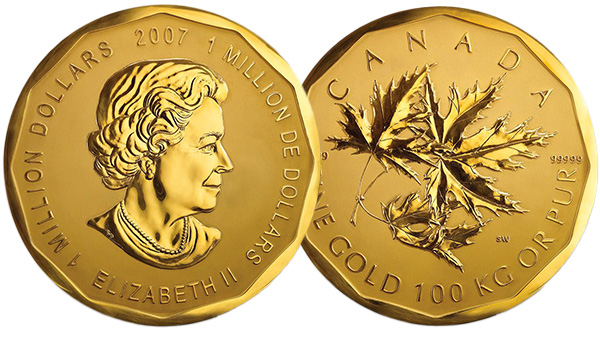
Produced as a set of six by the Royal Canadian Mint in 2007, this is one coin that literally more than holds its weight in bullion. It weighs 100kg (3,215 troy ounces), measures three centimeters thick, and has a diameter of 53 centimeters.
The face value is CA$ 1 million, making it a very valuable gold coin. But market estimates as of 2017 had it worth approximately US$4 million at market prices. It was listed in the Guinness Book of Records for its status as the world’s biggest gold coin and its purity of 99.999 percent.
The coin features a stylized maple leaf by RCM artist and senior engraver Stan Witten on the reverse and a portrait of Queen Elizabeth II on the obverse. Designed by Susanna Blunt, the Queen’s portrait shows her in “maturing dignity” without a tiara or crown.
In March 2017, one of the six copies of the Big Maple Leaf was stolen from the Bode Museum in Berlin, without triggering a single alarm. Two brothers and their cousin allegedly climbed through a window into the Bode and made away with the coin without tripping any alarms. The men were caught and sentenced, but the coin has yet to be found.
1933 Double Eagles
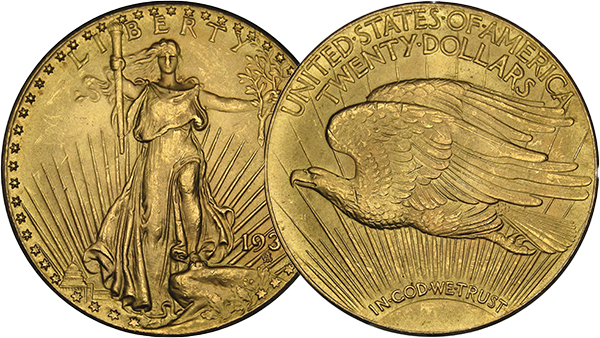
Double Eagles, specifically the 1933 Double Eagle, hold a special place in the world of rare and valuable gold coins. Designed by renowned artist Augustus Saint-Gaudens, the Double Eagle was minted from 1907 to 1933, originally in high relief. These coins were legal tender and had a face value of $20.
However, the 1933 Double Eagles became some of the rarest coins in existence due to a series of unique circumstances. That year, over 445,500 Double Eagles were produced, mostly by the San Francisco Mint. However, they were never officially released to the public.
In the midst of the Great Depression, President Franklin D. Roosevelt ordered all gold coins to be withdrawn from circulation, including the Double Eagles. Most were melted down into gold bars, leaving only a few in existence. However, two Double Eagles were intentionally spared from destruction. One is located at the National Numismatic Collection at the Smithsonian Institution, while the other is housed at the Federal Reserve Bank of New York.
There is also another 1933 Double Eagle, known as the "Weitzman Specimen," that is privately owned by renowned footwear designer Stuart Weitzman. This coin holds historical significance and has a fascinating and controversial past, including being a subject of a legal battle.
1787 Brasher Doubloon
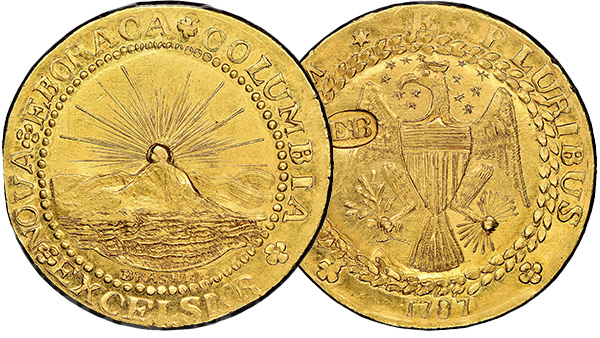
Noted for being the first gold coin struck in the U.S., the 1787 Brasher Doubloon was designed by Ephraim Brasher, a goldsmith and silversmith who was often asked to weigh and verify the authenticity of foreign gold coins for his customers.
He is noted for having joined with New York silversmith and sword maker John Bailey in requesting a franchise to produce American coinage in copper. However, the requests were denied as the State of New York decided they didn’t want to get into minting copper coinage. Following the unfavorable judgment, Brasher turned his attention to designing and minting gold doubloons.
On the obverse, the Brasher Doubloon displays the state seal – the sun rising over a mountain with the sea in the foreground – surrounded by the words “NOVA”, “EBORACA”, “COLUMBIA” and the state motto “EXCELSIOR”. The reverse has the U.S. eagle with shield, the motto “UNUM E PLURIBUS” and the date 1787.
Recognized by experts as being one of the first gold coins in the denomination of dollars, only seven copies of the coin are said to have survived. Six examples have Brasher’s initials stamped on the wing, while one has the stamp on the shield. A copy of the coin with the stamp on the wing sold for US$9.36 million in January 2021.
1621 Polish Ducat
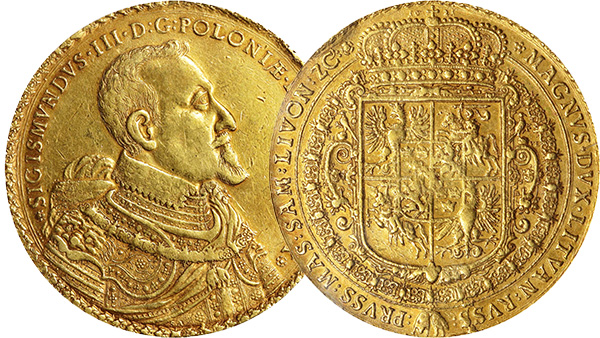
Issued for Poland’s King Sigismund III Vasa by Jacob Jacobson van Emden, this gold 100-ducat coin weighs 174.9g and measures nearly 7 centimeters in diameter.
The coin is believed to have been issued to mark the King’s success in holding off the powerful Ottoman army during the battle of Chocim. The obverse features the bust of King Sigismund III facing right, in ornamented armor and his commander’s sash. A symbol of a crusader and defender of Christianity against the Muslims in Europe. A small date “1621” is punched three times.
On the reverse, an extremely intricate rendition of the crowned coat of arms of the Polish-Lithuanian Commonwealth. There is a nine-field shield with the coats of arms of Poland, Lithuania, Sweden, and Gotland, as well as a sheaf, the symbol of the House of Vasa.
Only six copies are known to exist, each struck from the same die, engraved by Samuel Ammon. One copy, sold in the Classical Numismatic Group Triton XXI auction in 2018 is probably the finest. This fetched a record fee of US$2,160,000 (including Buyer’s Premium fee), making it the most expensive Polish coin ever minted.
1344 Edward III Florin
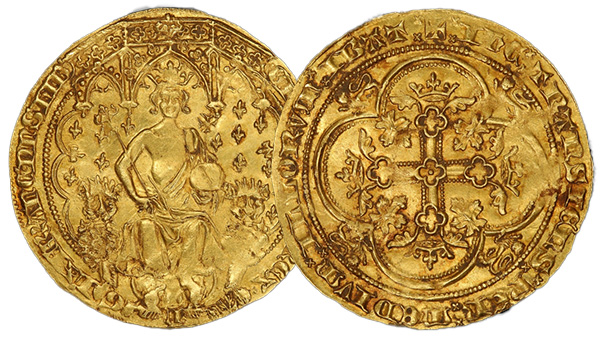
Also known as the “Double Leopard”, this coin was commissioned by Edward III and struck in 1344 as England’s first large-sized gold coin. Before that, English coinage was exclusively silver except for some gold pennies, so gold coins were needed for domestic and international trade.
The English florin features an image of the king under a canopy with two leopards’ heads at the sides on the obverse, hence the name “Double Leopard”. The reverse shows the royal cross within a quatrefoil, with a leopard in each spandrel.
The double leopard weighed 108 grains, or just under one-quarter of an ounce. It was assigned a value of six shillings. Sadly, gold leopard coinage was extremely short-lived as it was soon replaced by the gold noble. The gold leopards were officially demonetized on August 20, 1344.
Many were likely melted down as only three surviving examples are known. Two were discovered on the banks of the River Tyne and are held by the British Museum, while another was found in the south of England and sold at an auction.
696 Umayyad Gold Dinar
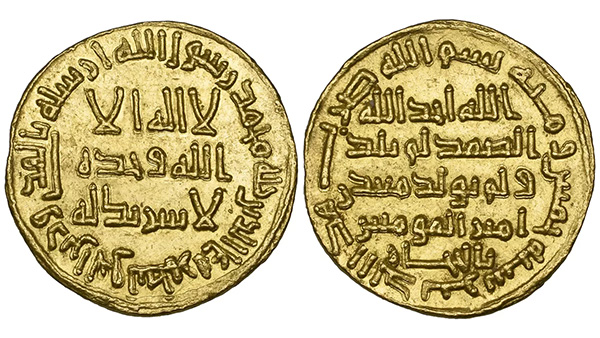
Early gold dinars were based on the style of Byzantine and Sasanian coins but began to take on a more uniquely Islamic style by 692 C.E.
The coin was likely minted in Damascus. It is significant because it’s the first coin to feature only the tenets of Islam. Following the fifth Umayyad caliph, Abd al-Malik’s gold reform in 696-97, new styles appeared without figural imagery.
Instead, they were replaced by Quranic verses and the shahada (the profession of faith). The inscription on one side reads: “There is no god but Allah alone. He has no partner”. On the reverse side, the inscription reads: “God is one, God is eternal. He was not born nor does He give birth.”
Along with the new design came a change in weight standards. The gold dinar standard was 4.25g, slightly lighter than the Byzantine standard of 4.38g.
LEGAL TENDER AND MINT STATE
Mint State
The condition of a coin is a major part of how a collector views its value and rarity. Coins in "Mint State", referring to coins that are in pristine condition, are highly sought after by collectors. Maintaining their original luster and surface quality, these coins have not suffered from wear or damage. Mint State coins showcase design details and features in their most pristine form, providing a true representation of the artist's intentions. Collectors value Mint State gold coins for their aesthetic appeal and the ability to acquire a piece of history that has remained untouched by time.
Legal Tender Status Of Rare Gold Coins
The legal tender status of rare gold coins plays a significant role in determining their value. Legal tender refers to the coins or banknotes that by law, must be accepted as a medium of exchange. In the case of rare gold coins, their legal tender status adds an extra layer of legitimacy and value.
The abandonment of the gold standard in 1933 further contributed to the rarity and increasing value of gold coins. The gold standard, which pegged the value of a currency to a fixed amount of gold, was abandoned by the United States during the Great Depression. This led to the confiscation of gold and the prohibition of private ownership. As a result, many gold coins were melted down, making the remaining ones even more scarce and valuable today.
Gold coins have a rich historical significance, dating back to ancient times when gold was used as a medium for trading material. Their connection to this ancient practice adds to their allure and the fascination collectors have with them. The rarity and historical significance of gold coins makes them highly sought-after by numismatic enthusiasts and collectors around the world.
The legal tender status of rare gold coins, along with the abandonment of the gold standard, has had a significant impact on their value. These coins represent not only a form of currency but also a tangible link to the past and the enduring allure of gold as a precious metal.
Determining A Coin's Mint State Condition
Determining a coin's mint state condition is a crucial factor in assessing its rarity and value. Mint state refers to the condition of a coin as it was when it left the mint; without any signs of wear or damage. Several criteria are considered to determine a coin's mint state.
One important factor is wear. The less wear a coin shows, the higher its mint state grade. Coins with minimal or no signs of wear are considered to be in higher mint state condition. Luster is another key factor. Luster refers to the way light reflects off the surface of a coin. A coin with full, vibrant luster indicates a higher mint state grade.
Flaws or damage can significantly affect a coin's grade. Scratches, visible nicks, or other imperfections can lower the mint state grade. Preservation of a coin's details is also important. Coins that retain their original design elements in full detail, with no smoothing or blurring of features, are considered to be in better mint state condition.
Professional grading services like PCGS, NGC, and ANACS play an essential role in assessing a coin's mint state. These organizations have experts with the knowledge and experience to evaluate coins objectively and assign accurate grades. Their services provide a standardized and trusted system for determining a coin's mint state condition.
Determining a coin's mint state condition involves considering factors such as wear, luster, flaws or damage, and the overall preservation of its details. Professional grading services are instrumental in providing accurate assessments of a coin's mint state. Collectors and numismatic enthusiasts rely on these evaluations to understand the rarity and value of coins in their collections.
PREVIOUS RECORD PRICES FOR RARE GOLD COINS
Rare gold coins have a long history of capturing the attention of collectors and investors alike. Over the years, several remarkable sales have set record prices for these sought-after treasures.
One such notable coin is the 1933 Saint-Gaudens Double Eagle, which holds the title of the most expensive gold coin ever sold at auction. This extraordinary coin fetched a staggering $7.59 million in 2002, showcasing the immense value placed on certain rare gold coins. Another renowned rarity is the Brasher Doubloon, struck by Ephraim Brasher in 1787. In 2011, this iconic gold coin sold for a record-breaking $7.4 million, making it one of the most valuable coins in existence.
These record prices not only reflect the rarity and historical significance of these coins but also highlight the passion and enthusiasm of collectors and investors for these exceptional pieces of numismatic art.
Record Price For Saint-Gaudens Double Eagle Coin
The Saint-Gaudens Double Eagle coin recently set a new record price in the numismatic world. This iconic gold coin, designed by renowned sculptor Augustus Saint-Gaudens, holds historical significance and is sought after by collectors worldwide.
Initially minted in the early 20th century, the Saint-Gaudens Double Eagle features Lady Liberty holding a torch and an olive branch, symbolizing freedom and peace, respectively. With a limited number of specimens in existence, this coin has become incredibly rare and valuable.
The Saint-Gaudens Double Eagle has been at the center of legal battles over the years, with ownership disputes adding to its allure. These legal battles have sparked interest and intrigue among collectors and investors, driving up its value.
In recent years, this rare gold coin has achieved staggering prices at various auctions. The most notable sale was in 2021 when a specimen fetched a record price of US $18.9 million. This sale surpassed the previous record set in 2002, highlighting the enduring appeal and value of the Saint-Gaudens Double Eagle.
As the market for rare coins continues to grow, the record-breaking prices of the Saint-Gaudens Double Eagle coin serve as a testament to its importance and desirability among collectors and investors alike. Its combination of historical significance, limited availability, and legal controversies ensures its place as one of the rarest and most valuable coins in existence.
FACTORS THAT IMPACT THE VALUE OF RARE GOLD COINS
Before you head out to buy gold coins, understand that there are several key factors that collectors consider when assessing their worth. These factors include rarity, condition, historical significance, and demand among collectors.
Rarity plays a significant role in determining the value of a rare gold coin. The fewer specimens of a particular coin that exist, the more valuable it becomes. Coins with limited mintage or those that were never circulated are highly sought after by collectors, driving up their value.
The condition of a rare gold coin also greatly impacts its value. Coins in mint state, which have not been circulated and are in pristine condition, command higher prices. The absence of any damage or wear enhances the coin's visual appeal and increases its desirability among collectors.
Historical significance adds value to rare gold coins. Coins that have a unique design, depict important figures, or commemorate significant events in history are highly prized by collectors. The story behind a coin and its connection to a specific era or historical event can significantly enhance its value.
Finally, demand among collectors substantially impacts the value of rare gold coins. If a particular coin is highly sought after and there is a limited supply available, the price will increase due to the competition among collectors to acquire it.
The rarity, condition, historical significance, and demand among collectors are all key factors that impact the value of rare gold coins. Collectors and investors carefully consider these elements when determining the worth of a coin. The truly rare gold coins are highly valuable and cherished in the world of numismatics.
